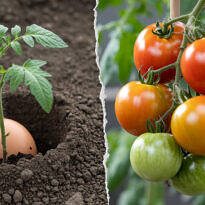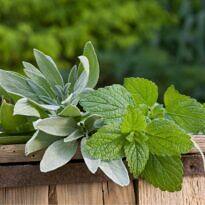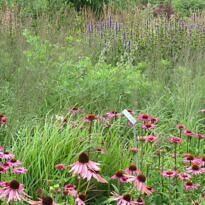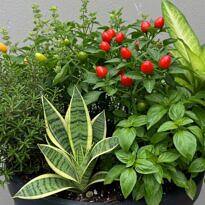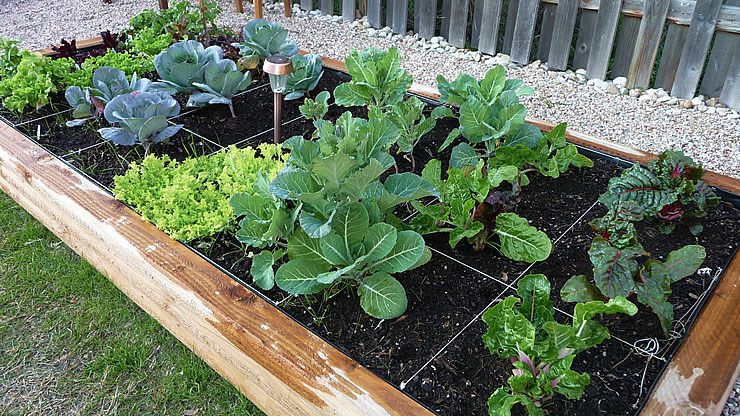
The “Garden Plot Schema” teaches how to create an organized and productive garden in a small space measuring 1.2 by 1.2 meters. This space is divided into squares, each with sides measuring 30 centimeters and a depth of 15cm. It was based on the Square foot model by Mel Bartholomew as a highly practical method of constructing a vegetable garden, and the idea gained tremendous success in 1981 in the United States. The difference is the metric system.
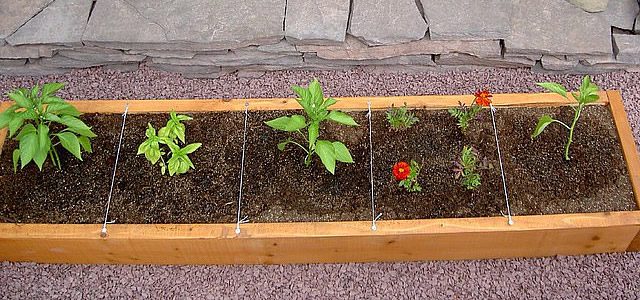
In this garden format, each square is dedicated to planting a variety of vegetables. Another principle is to use a mixture of vermiculite, potting soil, and fertilizers instead of garden soil enriched with compost. We can use potting mix based in peat to create our vegetable garden. This substrate can be easily found in agricultural supply stores and is often sold as seedbed substrate.
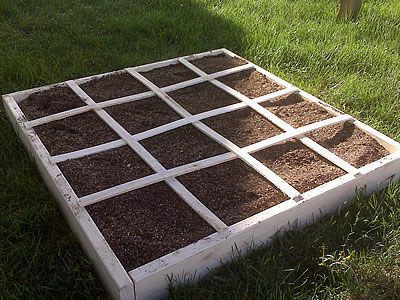
There are many advantages to this type of vegetable garden layout, including:
- High Yield: Intensive planting means you’ll harvest a lot from a small space, making it ideal for gardeners with limited room.
- Quick Setup: Planting using the “Garden Plot Schema” method is a fast way to start a new garden, making it great for beginners. You can place your garden bed anywhere – even on top of grass or paved areas – allowing you to build, fill, and start planting within hours. Even if you have a garden bed directly in the yard, you only need to prepare the planting areas, not the paths, which takes much less time and effort.
- Low Maintenance: With a small garden and only a few tasks to tend to each day, you’ll only need to invest a few minutes in planting, caring, and harvesting.
- Weed Control: When you install a “Vegetable Garden Plot Schema” garden using soil that’s not common garden soil, there will be fewer seeds (depending on the potting soil you use) and hence, there will be no weeds in the first planting cycle. However, weed emergence might become more frequent over time as they are brought by wind and contaminate the bed.
- Less Fertilization: Another benefit of the “Garden Plot Schema” garden is that you only need to fertilize once per cycle. The initial assembly provides adequate nutrition for the growth of most vegetables. Before starting the next cycle, just add more compost and fertilizer.
- Reduced Soil Compaction: It’s amazing what happens when you don’t step on the soil. It remains lighter and looser over time.
Small-sized vegetables are ideal for this garden model. Here, you can grow vegetables, herbs, and medicinal plants, whether annual or perennial. However, this technique is not suitable for plants that require a lot of space, like asparagus, pumpkins, watermelons, or corn.

Before beginning your “Garden Plot Schema” garden, select a good location. It should receive at least 6 to 8 hours of direct sunlight daily. Build it away from trees and bushes, as shade and roots can interfere. The location should have good drainage to prevent waterlogging during rain.
For the structure, use untreated quality wood. Avoid pine or other very fragile woods, as your garden bed will be in constant contact with the soil and moisture, making it prone to rot quickly. Do not use treated woods, as they can contaminate your substrate. You can also create your garden with cement blocks. They will be durable and even easier to assemble.
Plan to create a garden bed with a depth of 15 to 30 cm. For carrots and perennial plants, opt for greater depth. A drill, screwdriver, and some screws will be useful for assembling the box structure. However, you can use corner brackets to reinforce the structure and ensure it’s square. Keep in mind that each internal square will measure 30 x 30 cm, and the garden bed will generally be 1.20 x 1.20 m or even 1.20 x 2.40 m in total size.
If you plan to set up the box on grass, place a layer of geotextile fabric underneath to prevent weed growth. Alternatively, you can use cardboard or a thick layer of newspapers. The basic mixture for the substrate is ½ vermiculite and ½ potting soil, along with proportional organic fertilizers based on the volume of soil. Use bone meal, ashes, and oilseed cakes like castor or cotton. Follow the manufacturer’s guidelines. Well-rotted manure will also yield excellent results. You can also use ready-made pure substrates, such as Substrato Carolina, which is rich in peat and comes pre-fertilized.
You can create either an entire box or one already subdivided. If it’s an entire box, you’ll also need a grid to place over the box to separate the plants and plan your garden. The lines should divide the box into squares. Use wooden slats, plastic, or thicker ropes secured at the ends with nails or staples. Follow the recommended seed spacing provided by the supplier and plant only one seed in each square if the recommendation is 30 cm apart. For a 15 cm spacing, place 4 seeds in a square; a 10 cm spacing allows for 9 seeds, and a 7 cm spacing allows for 16 seeds.
To further maximize space, consider strategic planting times. This way, some plants will always be developing, making the box less crowded. An interesting benefit is that you can enjoy quickly maturing plants like lettuce throughout the season.
Soil in raised beds tends to dry out faster. Therefore, water daily during the summer heat to keep your plants growing well. You can skip daily watering by setting up an irrigation system with perforated hoses or drippers. Cover the substrate surface with organic mulch, such as grass clippings, sawdust, or torn newspapers, which also helps retain moisture and prevents weed growth.
There you have it! Your garden is ready! Now what? Discover how to fertilize your vegetables using 100% organic methods.


